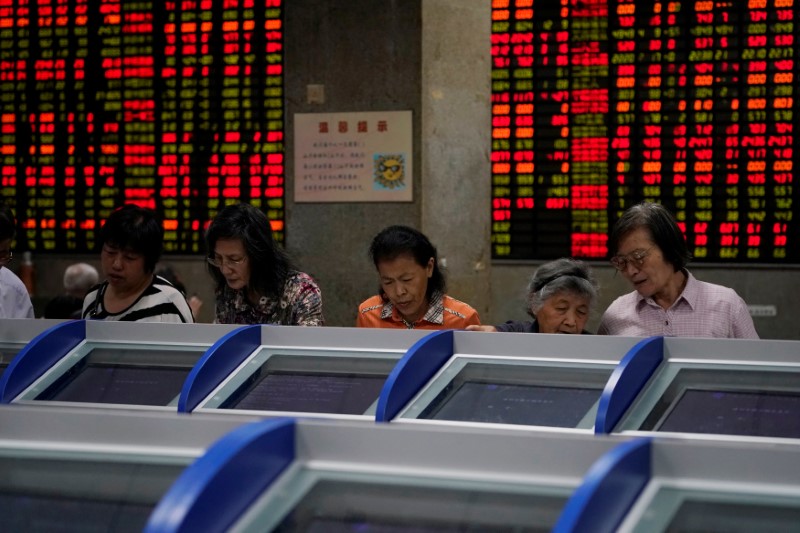
Investors look at computer screens showing stock information at a brokerage house in Shanghai, China June 20, 2018. REUTERS/Aly Song
June 28, 2018
SHANGHAI (Reuters) – Chinese shares fell back into the red in afternoon trading on Thursday, staying firmly on course for their worst monthly performance in years as tensions with the United States over trade continue to dim China’s economic outlook.
Trade worries also buffeted the yuan <CNY=CFXS>, with anxieties pulling it lower even as some analysts said the currency had further room to fall.
The benchmark CSI300 Index <.CSI300> and the Shanghai Composite Index <.SSEC> both gave up weak midday gains, deepening losses that pushed them into bear-market territory on Tuesday and Wednesday. At 0618 GMT, the Shanghai index <,SSEC> was down 0.5 percent and the blue-chip index <.CSI300> was off 0.6 percent.
The Shanghai benchmark has fallen about 9.5 percent in June, on track for its worst month since January 2016, when it tumbled 22 percent.
The stumbling indexes once again highlighted the difficulties Chinese policymakers face in stabilizing markets amid an ongoing deleveraging campaign.
The spot yuan market <CNY=CFXS> opened at 6.6177 per dollar and around 0620 GMT was changing hands at 6.6153, which is 133 pips or 0.2 percent weaker than the previous late session close.
In each of the past six days, the yuan has slid, taking it to its lowest levels since December 2017.
BIGGEST DROP SINCE 1994
The yuan has dropped more than 3 percent against the U.S. dollar June, more than in any other month since 1994 when China unified the market exchange rate.
A trader at a Chinese bank in Shanghai said it remained unclear whether a large amount of dollar selling around midday on Wednesday was on behalf of the central bank or corporate clients. The dollar-selling had slowed the pace of yuan losses as investors stopped aggressively testing lows for the Chinese currency.
Traders said they did not see any unusual or suspicious dollar selling on Thursday morning.
Some analysts said the currency has farther to fall, given its continued strength against other emerging market currencies.
“I think there is no urgency for the PBOC to stop the yuan from weakening further, as the RMB index has still appreciated year to date” said Tommy Xie, an economist at OCBC in Singapore.
He said the People’s Bank of China “is in the market to keep volatility in check, but not to change the direction of movement.”
However, Xie added that excessive weakening could prompt the central bank to reintroduce its “counter-cyclical factor” in calculating the yuan’s midpoint.
The bank introduced the factor last year in what it said was an attempt to better reflect supply and demand, and reduce possible market “herd effects”. Traders said the mechanism helped reduce volatility.
Market volatility in China “is being driven by a combination of factors – Sino-U.S. trade tensions, concerns over corporate bond defaults in China and uncertainties to the growth outlook,” Tai Hui, J.P. Morgan Asset Management’s chief market strategist for Asia-Pacific, said in a note.
“Worries over corporate bond defaults are arguably the most dominant factor at this point, since the prospects of higher USD interest rates and subsequent USD strength are raising concerns that companies who have been heavy USD debt issuers could face challenges to service their debt, repay or refinance.”
Chinese 10-year treasury futures for September delivery <CFTU8>, the most traded contract, were 0.15 percent higher on Thursday.
A government think-tank report that appeared briefly online said that China should be wary of any financial panic stemming from uncertainties, such as bond defaults, tight liquidity and trade frictions with the United States.
(Reporting by John Ruwitch, Samuel Shen, Winni Zhou and Andrew Galbraith; Editing by Richard Borsuk)

